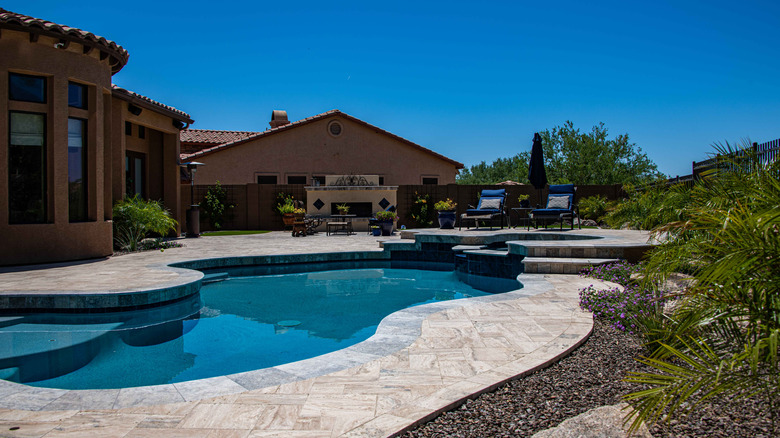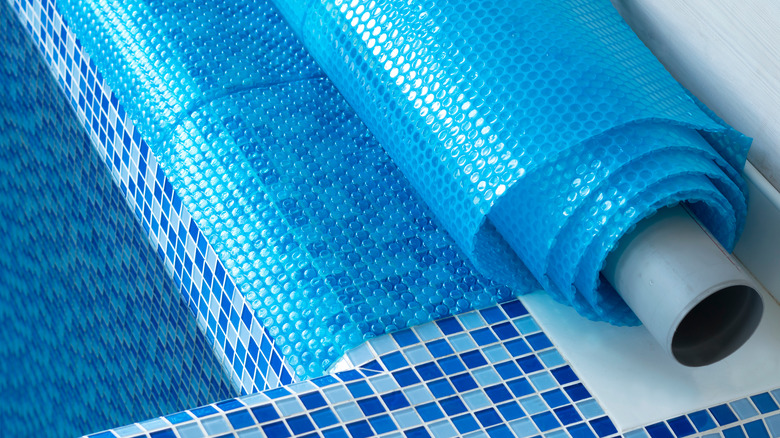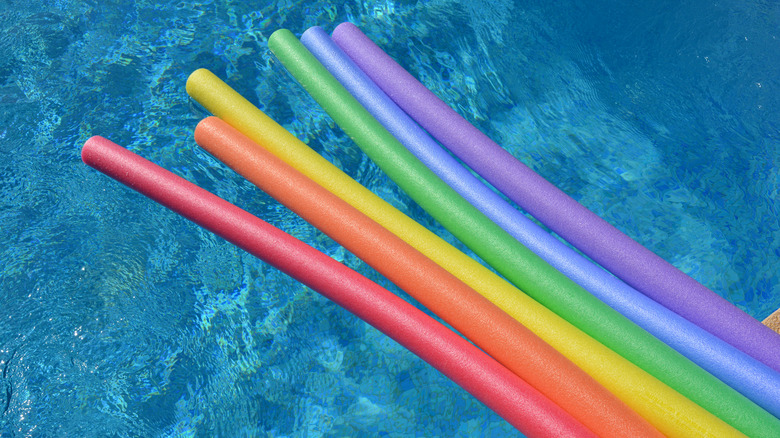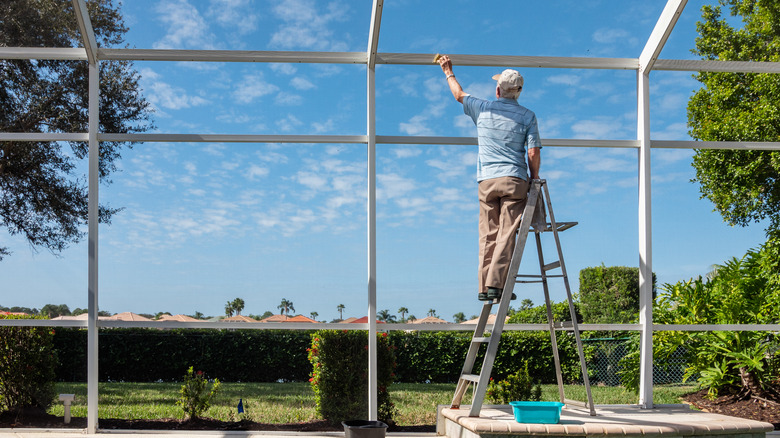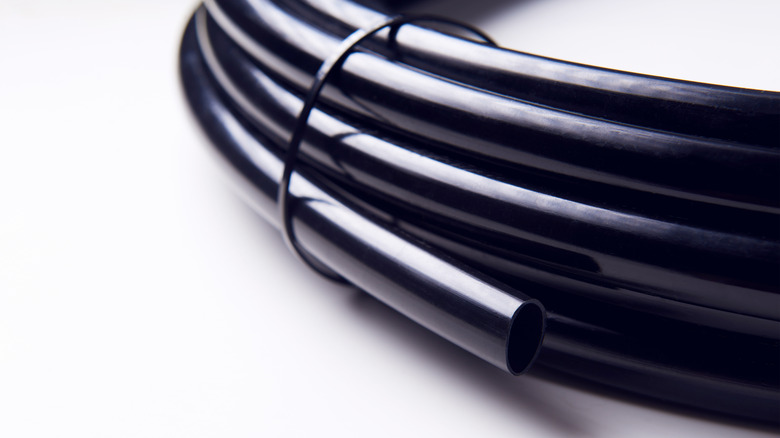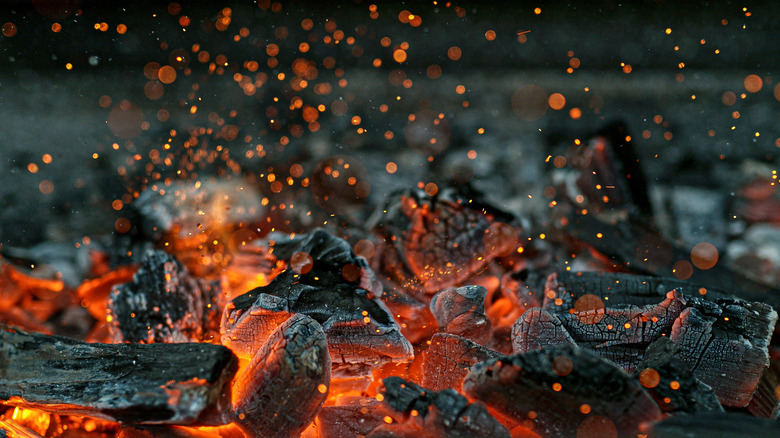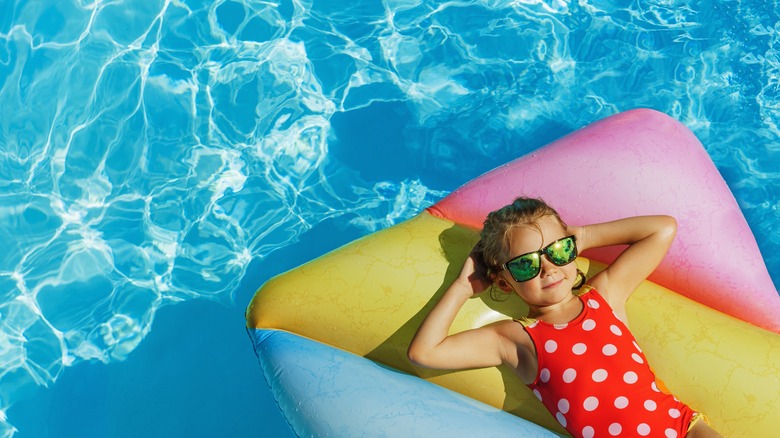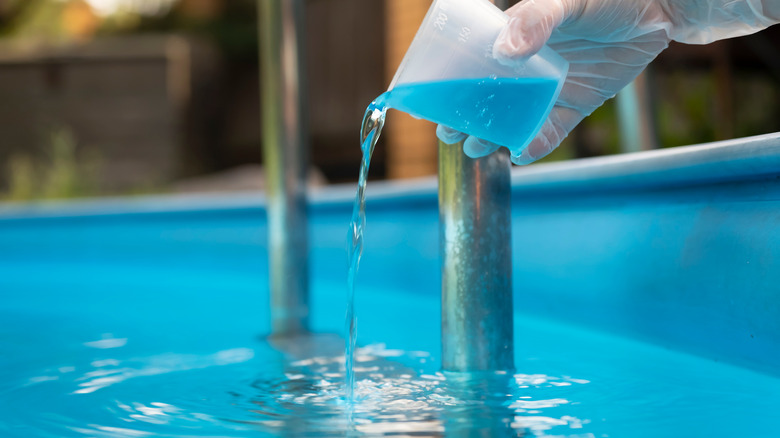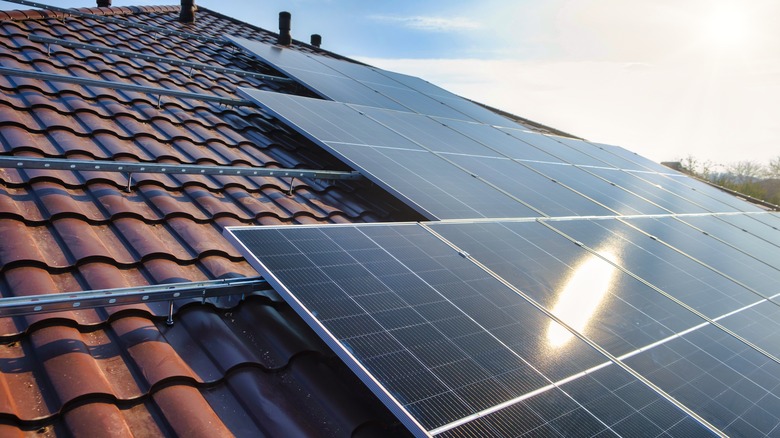Creative Ways To Warm Up Your Pool Without A Heater
Heating the water of your pool is an essential task for any homeowner looking to gain year-round access to this backyard feature. A heated pool is a unique commodity that can increase home value and a relaxation space that can be used regardless of what the weather is like outside. But installing a traditional heating system for your pool can be incredibly costly, with Angi noting that a typical installation can run a homeowner around $3,000, depending on your size requirements and extra amenities.
What's more, adding a pool heater to the inner workings of your pump system and pool deck can be significantly labor intensive, raising the price of this work substantially when adding in labor costs. Moreover, the standard pool heater relies on a gas powered system, requiring you to continuously pay to have this precious resource delivered to your home. Fortunately, a traditional gas pool heater isn't the only option for drawing heat from the environment and warming the temperature of the pool water. With a few creative approaches to water temperature management, it's possible to implement simple and highly cost-effective heating solutions designed to improve your swimming experience.
Use a solar blanket to insulate the pool
A solar blanket is a great option for insulating your pool. This is one of the first tools that homeowners might use to provide additional heat to the water feature, because they are easy to find and even easier to use. Solar pool covers are often made from black or other dark colored plastic or silicone material, and include air pockets across the area of the covering — similar to a giant sheet of bubble wrap (via Castle Hot Tubs). When placed on top of the pool, this covering will rest directly on the water and provide a barrier that prevents heat from rising out of the water and back into the cooler air above. Similarly, this dark colored coating attracts heat from the sun and will warm up faster than the water itself. This is due in part to the fact that pools typically make use of light colored flooring elements, therefore this change to something darker speeds up the process of natural solar heating. The collected heat is then transferred directly into the pool water through physical contact.
Solar blankets work as a heat trap and as insulation for the temperature contained within your pool's water. These are a great option for use in extending the functional pool season at your home. Laying a solar blanket cover over your pool at night will help insulate the water and, as the sun comes up in the morning, it will prevent evaporation from drawing the heat out even faster. Castle Hot Tubs also reports that these types of solar blanket coverings can prevent heat loss by as much as 15 degrees Fahrenheit. This is a significant amount of heat that you can retain in the pool, making for a far more enjoyable swim during cooler months when other homeowners have long since closed up their pools for the season.
Solar rings provide the same benefit while allowing for direct sunlight
Instead of using a solar blanket covering that expands across the entire surface of your pool area, you could opt for solar rings instead. These devices employ the same kinds of technology that make the solar blanket a viable option for keeping warmth within your pool water. However, solar rings are much smaller, and you can add as many or as few as you want in your efforts at temperature regulation. (wikiHow suggests covering roughly 80% of the pool surface with this addition.) Because this device doesn't expand out to the edges of the pool, you may need to use pool noodles or other flotation devices to keep them afloat. You could even construct your own with pool noodles and trash bags for a cost-effective, DIY approach (via Made with Happy). Either option will keep them floating on top of the water's surface rather, than sinking down beneath and losing efficacy.
While these may not provide the same blanketing effect as a larger, single unit cover, solar rings give you the ability to swim in the pool without the hassle of removing an entire layer from the water's surface. Solar rings are highly useful and easily deployed as a result of this unique benefit. Another key feature of solar rings is that your pool water will still retain direct access to sunlight. A critical drawback of a complete solar covering is that blocking out the sun can lead to increased algae growth within the water. Using solar rings allows for an important volume of UV radiation to come into contact with the pool water, resulting in a slower rate of growth of algae and bacteria that may exist in the chemistry of your pool water. This can be a much better solution to pool heat retention for homeowners who have experienced issues like this in the past. Similarly, it can be much easier to store unused solar rings when the temperature heats back up and they are no longer needed.
Build fencing or a screen enclosure around the pool
Fencing around the pool is another good option for homeowners looking to make a sustainable change to this outdoor amenity. Any augmentation that expands the effective usage timeline, without adding an ongoing expense to the home budget, is a great option, and enclosures fit this bill perfectly. Simple fencing around the pool can effectively reduce or even eliminate the wind factor that sucks heat away from the surface of your pool water. Fencing is also a great safety feature for homeowners who have young children. It's for this reason that all new pools and pool deck renovations recommend the addition of either permanent or movable fence posts to create a barrier around this potential hazard (via U.S. Consumer Product Safety Commission). Adding this windscreen around your pool deck can provide a simple, but highly effective, solution for reducing one source of temperature drain on the water in your pool.
Another option is to build a screen enclosure around the entire pool deck. A screen enclosure makes use of light aluminum beams to hold the screen in place, and Angi reports that you can expect to pay anywhere from $8 to $200 per square foot for this installation. This project may not be a cheap alternative to installing a traditional heating element to link in with your pool pump and filter, but it will eliminate an ongoing cost. For one thing, a screened enclosure will act as a wind barrier in the same way that other fencing elements do, maintaining better equilibrium of the water's temperature. A screened enclosure will also keep falling leaves and pests out of your pool and away from your deck. This can make for a much more enjoyable swimming or relaxation experience on a regular basis.
Install a dedicated black hose
The black hose is a tried and true method of increasing the temperature within your pool. Homeowners often resort to this method, according to users discussing the matter at Trouble Free Pool. In the same way that a black solar blanket or other tarp-like device will raise the temperature as a result of faster heating from the sun's rays, a black hose will warm faster than one with a green, white, or any other light color. Using this long, black hose, attach one end to the pool pump in order to suck water from the pool through the hose. Then, all you have to do is place the outflow end in the pool to create a loop that draws water through this heated element (via wikiHow). Over time, this strategy will raise the equilibrium temperature of your pool, because you will have incorporated a part that is consistently hotter than the overall temperature. Used in tandem with floating solar rings, a wind barrier, or any other strategy for enhancing the temperature, this hose makes for an even greater asset.
Another option when installing a natural heating hose is the addition of copper piping to this loop. A copper section is a more permanent installation and can't easily be taken apart or put away during the warmer months when it isn't needed. As such, you'll want to be sure that this additional length and permanent installation will achieve the result you're looking for. In the same way that a black hose will heat up faster than a light colored one, metal piping will become warm rapidly in the sun. Installing a segment of copper piping that runs back and forth against the house (near your pool pump, of course), in an area that sees a considerable amount of sunlight, can improve upon this already productive system tremendously.
Take your hose system to the next level with a wood-burning circuit
To expand upon the idea of creating a water pump loop, you might consider building a fixture onto an existing fire pit in your backyard. In the same way that a furnace or fireplace can be used to pipe hot smoke throughout a network of radiators in a home, you can use your fire pit to heat water being pumped around a warming circuit from the pool (via Instructables). With the same method of added copper piping to establish a more permanent addition to the black hose, you can build a circuit of copper piping that runs directly into a fire pit, and then attaches back to a hose — or any other method of returning water to the pool. Your fire pit will produce an abundance of heat once you've begun burning logs within it. Simply pumping water from the pool through the network of hose pipe and copper tubing will return water to the pool with much greater heat energy in tow.
Admittedly, building this kind of heating apparatus will take a good amount of work, and may provide limited application beyond use as a simple water heater. However, those who love to tackle DIY projects or learn how complex systems work through their own tinkering and hands-on experience, may find a significant amount of enjoyment in a project like this. What's more, anytime you invite friends over to sit at the fire pit, there will be a built-in talking point that you can show off.
Establish a solar mat array in the adjacent lawn space
A solar mat array works in the same way that a hose or dedicated fire pit-turned furnace operate. This is another strategy that involves pulling water from the pool. You will be seeking to draw this water through natural heating elements arranged in the lawn, before pumping it back into the pool. Solar mats require a bit more space than some other options though. Instead of a simple hose or a sophisticated copper piping buildout that runs along the house or into an added fire pit, solar mats are flattened elements that perform the same basic function. Do It Wrong Yourself notes that you could even run black tubes in large round spirals on constructed platforms to achieve this feature.
Instead of placing these heating mechanisms on top of the water surface, you'll arrange these mats on the ground next to the pool. Pumping water through your solar mat array moves the water through the vinyl or plastic mats that soak up sunlight more aggressively than smaller installations. Often, these mats will include tightly packed tubing within the material (or as the primary layer) that forces the water back and forth through each heated section. As with any other strategy that employs a similar type of effective — albeit primitive — technology, the more contact the water has with these heated sections, the warmer you can expect your pool to become.
One benefit of the solar mat option is that, with a strong enough pump, you can actually place these on the roof, rather than relying on a warming solution that requires closer proximity. Any roofer will tell you that the roof of a home can easily rise 5 to 20 degrees higher than the temperature on the ground (via Lindholm Roofing). This means that you can expect to not only see a substantial square footage of surface area heating the water, but you'll also achieve much warmer temperatures than you would at ground level.
Consider liquid augmentations for short term fixes
Liquid solar cover is another option that homeowners can use in defense of their pool temperature. These products come in bottles and are poured directly into the pool, or the skimmer on the side, in an effort to pull the solution directly through the pump for a more spread out application across the water. Liquid solar cover products are not as effective as a physical barrier, and you may need to apply multiple treatments in order to achieve the desired effect at certain times of the year. Therefore, liquid augmentation products might be a good backup solution, or used as an addition, to other strategies for maintaining consistent heat in the pool.
These liquid products make use of an alcohol solution to form a barrier between the air above the pool and the water within it (via Swim University). Alcohol and water have differing densities, and alcohol will float on top of a mixed solution that incorporates water. As such, an alcohol product can be used to form a natural barrier in the same way that physical solar covers or rings do. Even though a liquid cover won't be as effective as a physical one, these products can reduce evaporation of pool water by as much as 85%, making them a useful option regardless of how they stack up against other choices.
Install solar panels at home for multiple energy benefits
Lastly, the installation of solar panels can provide a tremendous boost to the temperature regulation of your pool water. Solar panels are by no means the cheapest option on this list, but they provide a raft of other benefits that come along with the ability to heat your pool throughout the year. The installation of solar panels in residential settings very much seems to be the way of the future. USA Facts reports that there are roughly three million solar energy installations on residential buildings in the U.S. as of April 2022. Of these three million solar panels, one third of them were built in the last two years. Similarly, since the 2005 introduction of solar tax credits, new solar installations in homes have increased by an annualized rate of 32% each year.
Solar panels can play an integral role in reducing your monthly energy bill by a significant margin. SolarReviews notes that it takes between nine and 12 years for the cost of a solar panel installation to break even in relation to the energy savings that a homeowner will enjoy. However, if you use solar power for an expanded number of tasks, specifically using solar collectors to run heating elements that warm your pool water, it may be possible to reduce this timeline even further. Solar heating is an exceptional way to remedy the common issue of a cold pool. With the installation of solar panels on your roof, you can reduce your dependence on the grid for lighting and heating tasks in the home and yard — and they can increase your home value, too.
